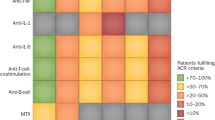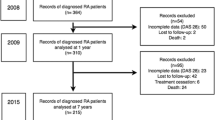Abstract
The concept of remission in rheumatology is complicated by the lack of a single gold standard measurement, spontaneous remissions and the usage of several sets of remission criteria. Feasibility is reduced by traditional clinical practice, which does not include remission criteria monitoring. The “window of opportunity” to prevent joint damage with DMARD therapy lasts only a few months. The perspective of the physician and patient differ, as the former gives importance to signs of disease activity, whereas the latter to disability and quality of life. All patients with rheumatoid arthritis are candidates for combination DMARD-based therapy, which should be instituted without delay. Remission is important to prevent joint destruction, preserve adequate quality of life and prevent disability. The introduction of biological agents has made this objective feasible, but the failure rate is still high (about 50%), on account of lack of response, contraindications and intolerance.
Similar content being viewed by others
References
Pincus T, Kavanaugh A, Aletaha D, Smolen J (2006) Complexities in defining remission in rheumatic diseases. Clin Exp Rheumatol 24(Suppl 43):S1–S6
Smolen JS, Aletaha D (2006) What should be our treatment goal in rheumatoid arthritis today? Clin Exp Rheumatol 24(Suppl 43):S7–S13
Maekinen H, Hannonen P, Sokka T (2006) Definitions of remission for rheumatoid arthritis and review of selected clinical cohorts and randomized clinical trials for the rate of remission. Clin Exp Rheumatol 24(Suppl 43):S22–S28
Landewé R, van der Heijde D, van der Linden S, Boers M (2006) Twenty-eight joint counts invalidate the DAS28 remission definition owing to the omission of the lower extremity joints: a comparison with the original DAS remission. Ann Rheum Dis 65:637–641. doi:10.1136/ard.2005.039859
Gossec L, Dougados M, Goupille P, Cantagrel A, Sibilia J, Meyer O et al (2004) Prognostic factors for remission in early rheumatoid arthritis: a multiparameter prospective study. Ann Rheum Dis 63:675–680. doi:10.1136/ard.2003.010611
Molenaar ETH, Voskuyl AE, van der Horst-Bruinsma IE, Schreuder GMT, Zanelli E, Dijkmans BAC (2002) Influence of HLA polymorphism on persistent remission in rheumatoid arthritis. Ann Rheum Dis 61:351–353. doi:10.1136/ard.61.4.351
Drozdzik M, Rudas T, Pawlik A, Kurzawski M, Czerny B, Gornik W et al (2006) The effect of 3435C>T MDR1 gene polymorphism on rheumatoid arthritis treatment with disease-modifying antirheumatic drugs. Eur J Clin Pharmacol 62:933–937. doi:10.1007/s00228-006-0192-1
Verstappen SMM, van Albada-Kuipers GA, Bijlsma JWJ, Blaauw AAM, Schenk Y, Haanen HCM, Jacobs JWG, On behalf of the Utrecht Rheumatoid Arthritis Cohort Study Group (2005) A good response to early DMARD treatment of patients with rheumatoid arthritis in the first year predicts remission during follow-up. Ann Rheum Dis 64:38–43. doi:10.1136/ard.2003.014928
Forslind K, Hafstroem I, Ahlmen M, Svensson B, for the BARFOT study group (2007) Sex: a major predictor of remission in early rheumatoid arthritis? Ann Rheum Dis 66:46–52. doi:10.1136/ard.2006.056937
Breedveld FC, Kalden JR (2004) Appropriate and effective management of rheumatoid arthritis. Ann Rheum Dis 63:627–633. doi:10.1136/ard.2003.011395
Sesin CA, Bingham CO (2005) Remission in rheumatoid arthritis: wishful thinking or clinical reality? Semin Arthritis Rheum 35:185–196. doi:10.1016/j.semarthrit.2005.06.003
Grigor C, Capell H, Stirling A, McMahon AD, Lock P, Vallance R et al (2004) Effect of a treatment strategy of tight control for rheumatoid arthritis (the TICORA study): a single-blind randomized controlled trial. Lancet 364:263–269. doi:10.1016/S0140-6736(04)16676-2
Maekinen H, Kautiainen H, Hannonen P, Sokka T (2005) Frequency of remissions in early rheumatoid arthritis defined by 3 sets of criteria. A 5-year follow-up study. J Rheumatol 32:796–800
Cohen SB, Emery P, Greenwald MW, Dougados M, Furie RA, Genovese MC, Keystone EC, Loveless JE, Burmester GR, Cravets MW, Hessey EW, Shaw T, Totoritis MC, REFLEX Trial Group (2006) Rituximab for rheumatoid arthritis refractory to anti-tumor necrosis factor therapy: Results of a multicenter, randomized, double-blind, placebo-controlled, phase III trial evaluating primary efficacy and safety at twenty-four weeks. Arthritis Rheum 54:2793–2806
Mierau M, Schoels M, Gonda G, Fuchs J, Aletaha D, Smolen JS (2007) Assessing remission in clinical practice. Rheumatology 1–5
Van der Helm-van Mil AHM, Breedveld FC, Huizinga TWJ (2006) Definition of disease states in early arthritis: remission versus minimal disease activity. Arthritis Res Ther 8:216. doi:10.1186/ar1983
Brown AK, Quinn MA, Karim Z, Conaghan PG, Peterfy CG, Hensor E et al (2006) Presence of significant synovitis in rheumatoid arthritis patients with disease-modifying antirheumatic drug-induced clinical remission. Evidence from an imaging study may explain structural progression. Arthritis Rheum 54:3761–3773. doi:10.1002/art.22190
Voskuyl AE, Dijkmans BAC (2006) Remission and radiographic progression in rheumatoid arthritis. Clin Exp Rheumatol 24(Suppl 43):S37–S40
Goekoop-Ruiterman YPM, de Vries-Bouwstra JK, Allart CF, van Zeben D, Kerstens PJSM, Hazes MW et al (2007) Comparison of treatment strategies in early rheumatoid arthritis. A randomized trial. Ann Intern Med 146:406–415
American College of Rheumatology Subcommittee on Rheumatoid Arthritis Guidelines (2002) Guidelines for the management of rheumatoid arthritis 2002 update. Arthritis Rheum 46:328–346. doi:10.1002/art.10148
Hochberg MC, Lebwohl MG, Plevy SE, Hobbs KF, Yocum DE (2005) The benefit/risk profile of TNF-blocking agents: findings of a consensus panel. Semin Arthritis Rheum 34:819–836. doi:10.1016/j.semarthrit.2004.11.006
Valesini G, Montecucco C, Cutolo M (2006) Recommendations for the use of biologic (TNF-alpha blocking) agents in the treatment of rheumatoid arthritis in Italy. Clin Exp Rheumatol 24(4):413–423
Fautrel B, Constantin A, Morel J, Vittecoq O, Cantagrel A, Combe B et al (2006) Recommendations of the French Society for Rheumatology. TNFα antagonist therapy in rheumatoid arthritis. Joint Bone Spine 73:433–441. doi:10.1016/j.jbspin.2006.04.001
Cannella AC, O’Dell JR (2003) Is there still a role for traditional disease-modifying antirheumatic drugs (DMARDs) in rheumatoid arthritis? Curr Opin Rheumatol 15:185–192. doi:10.1097/00002281-200305000-00003
Sokka T, Hannonen P, Moettoenen T (2005) Conventional disease-modifying antirheumatic drugs in early arthritis. Rheum Dis Clin North Am 31:729–744. doi:10.1016/j.rdc.2005.07.007
Boers M, Verhoeven AC, Markusse HM et al (1997) Randomized comparison of combined step-down prednisolone, methotrexate and sulphasalazine with sulphasalazine alone in early rheumatoid arthritis. Lancet 350:309–318. doi:10.1016/S0140-6736(97)01300-7
Möttönen T, Hannonen P, Leirisalo-Repo M et al, for the FIN_RACo trial group (1999) Comparison of combination therapy with single-drug therapy in early rheumatoid arthritis: a randomized trial. Lancet 353:1568–1573
Dougados M, Emery P, Lemmel EM, de la Serna R, Zerbini CA, Brin S et al (2003) Efficacy and safety of leflunomide and predisposing factors for treatment response in patients with active rheumatoid arthritis: RELIEF 6-month data. J Rheumatol 30:2572–2579
Van der Heijde D, Klareskog L, Rodriguez-Valverde V, Codreanu C, Bolosiu H, Melo-Gomes J, for the TEMPO study investigators (2006) Comparison of etanercept and methotrexate, alone and combined, in the treatment of rheumatoid arthritis. Two-year clinical and radiographic results from the TEMPO study, a double-blind, randomized trial. Arthritis Rheum 54:1063–1074. doi:10.1002/art.21655
Breedveld FC, Weisman MH, Kavanaugh AF, Cohen SB, Pavelka K, von Vollehoven R et al. for the PREMIER investigators. The PREMIER study (2006) A multicenter, randomized, double-blind clinical trial of combination therapy with adalimumab plus methotrexate versus methotrexate alone or adalimumab alone in patients with early, aggressive rheumatoid arthritis who had not had previous methotrexate treatment. Arthritis Rheum 54:26–37. doi:10.1002/art.21519
Hyrich KL, Symmons DP, Watson KD, Silman AJ, On behalf of the British Society for Rheumatology Biologics Register (2006) Comparison of the response to infliximab or etanercept monotherapy with the response to cotherapy with methotrexate or another disease-modifying antirheumatic drug in patients with rheumatoid arthritis: results from the British Society for Rheumatology Biologics Register. Arthritis Rheum 54:1786–1794. doi:10.1002/art.21830
St Clair EW, van der Heijde DMFM, Smolen JS et al. for the active controlled study of patients receiving infiliximab for the treatment of rheumatoid arthritis of early onset study group (2004). Arthritis Rheum 50:3432–3443. doi:10.1002/art.20568
Hyrich KL, Watson KD, Silman AJ, Symmons DPM and the BSR Biologics Register (2006b) Predictors of response to anti-TNF-α therapy among patients with rheumatoid arthritis: results from the British Society for Rheumatology Biologics Register. Rheumatology 45:1558–1565. doi:10.1093/rheumatology/kel149
Kremer JM, Genant HK, Moreland LW, Russell AS, Emery P, Abud-Mendoza C et al (2006) Effects of abatacept in patients with methotrexate-resistant active rheumatoid arthritis: a randomized trial. Ann Intern Med 144:865–876
Genovese MC, Becker JC, Schiff M, Luggen M, Sherrer Y, Kremer J et al (2005) Abatacept for rheumatoid arthritis refractory to tumor necrosis factor alpha inhibition. N Engl J Med 353:1114–1123. doi:10.1056/NEJMoa050524
Schiff M, Keiserman M, Codding C, Songcharoen S, Berman A, Nayiager S et al (2007) Efficacy and safety of abatacept or infliximab versus placebo in ATTEST: a phase III, multicenter, randomized, double-blind, placebo-controlled study in patients with rheumatoid arthritis and an inadequate response to methotrexate. Ann Rheum Dis published online 29 Nov 2007
Coehn SB, Emery P, Greenwald MW, Dougados M, Furie RA, Genovese MC et al (2006) Rituximab for rheumatoid arthritis refractory to anti-tumor necrosis factor therapy: results of a multicenter, randomized, double-blind, placebo-controlled, phase III trial evaluating primary efficacy and safety at twenty-four weeks. Arthritis Rheum 54:2793–2806. doi:10.1002/art.22025
Combe B, Landewe R, Lukas C, Bolosiu HD, Breedveld F, Dougados M et al (2007) EULAR recommendations for the management of early arthritis: report of a task force of the European standing committee for international clinical studies including therapeutics (ESCISIT). Ann Rheum Dis 66:34–45. doi:10.1136/ard.2005.044354
Möttönen T, Hannonen P, Korpela M, for the FIN_RACo trial group et al (2002) Delay to institution of therapy and induction of remission using single-drug or combination disease modifying antirheumatic drug therapy in early rheumatoid arthritis. Arthritis Rheum 46:894–898. doi:10.1002/art.10135
Anderson JJ, Wells G, Verhoeven AC, Felson DT (2000) Factors predicting response to treatment in rheumatoid arthritis: the importance of disease duration. Arthritis Rheum 43:22–29. doi:10.1002/1529-0131(200001)43:1<22::AID-ANR4>3.0.CO;2-9
Furst DE, Breedveld FC, Kalden JR, Smolen JS, Burmester GR, Sieper J et al (2007) Updated consensus statement on biological agents for the treatment of rheumatic diseases, 2007. Ann Rheum Dis 66:2–22
Aletaha D, Smolen JS (2006) Remission of rheumatoid arthritis: should we care about definitions? Clin Exp Rheumatol 24(Suppl 43):S45–S51
Rupp I, Boshuizen HC, Dinant HJ, Jacobi CE, van der Bos GAM (2006) Disability and health-related quality of life among patients with rheumatoid arthritis: association with radiographic joint damage, disease activity, pain, and depressive symptoms. Scand J Rheumatol 35:175–181. doi:10.1080/03009740500343260
Kvien TK, Uhlig T (2005) Quality of life in rheumatoid arthritis. Scand J Rheumatol 34:333–341. doi:10.1080/03009740500327727
Krishnan E, Haekkinen A, Sokka T, Hannonen P (2005) Impact of age and comorbidities on the criteria for remission and response in rheumatoid arthritis. Ann Rheum Dis 64:1350–1352. doi:10.1136/ard.2005.037903
Rupp I, Boshuizen H, Jacobi CE, Dinant HJ, van den Bos GAM (2004) Comorbidity in patients with rheumatoid arthritis: effect on health-related quality of life. J Rheumatol 31:58–65
Conflict of interest statement
Guido Valesini has received International and National Advisor Board consultancies by Bristol Myers Squibb and honoraria by several pharmaceutical companies that are marketing agents for the treatment of rheumatic diseases.
Author information
Authors and Affiliations
Corresponding author
Rights and permissions
About this article
Cite this article
Valesini, G., Di Franco, M., Spinelli, F.R. et al. Induction of remission in rheumatoid arthritis: criteria and opportunities. Rheumatol Int 29, 131–139 (2008). https://doi.org/10.1007/s00296-008-0699-0
Received:
Accepted:
Published:
Issue Date:
DOI: https://doi.org/10.1007/s00296-008-0699-0




